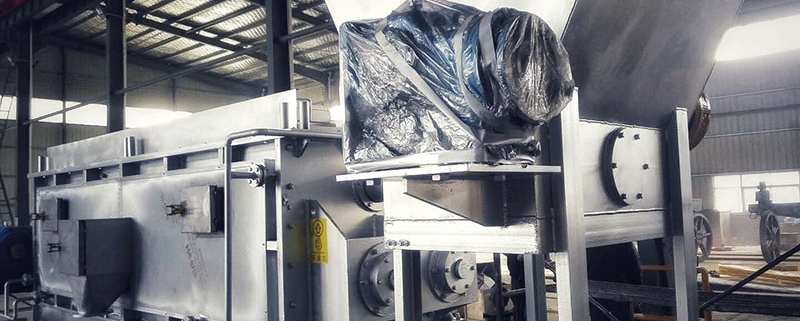Both the agitator shaft of the paddle dryer and the blades welded to the shaft are hollow structures. The shape of the blade is a wedge-shaped hollow semi-circular shape, which can be passed into the heat transfer medium. In addition to stirring, it is also the heat transfer surface of the device. The blade is triangular, and the sides of the two main heat transfer surfaces are inclined. When the material is in contact with the inclined surface, the material quickly slides off the inclined surface as the surface of the surface rotates, resulting in a self-cleaning effect, so that the heat transfer surface is continuously updated. , thus enhancing heat transfer efficiency. A scraper is arranged at the bottom of the triangle of the blade to scrape the material deposited on the bottom of the shell to prevent the material in the drying chamber from forming a dead angle and to make the product moisture uniform.
Hollow paddle dryer structure
The structure of the hollow blade dryer is mainly composed of a transmission mechanism part, a box part, a main shaft stirring part, a bearing body part, a discharge adjusting mechanism, a rotary joint and the like.
Power transmission part: mainly composed of electric motor, reducer, drive gear, driven gear, inter-shaft gear, etc. Its main function is to transmit the power of the motor to the agitating part of the main shaft to make it run within the rated speed range. It can also be equipped with variable frequency speed regulation or electromagnetic speed regulation configuration for variable speed operation.
The main shaft stirring part is mainly composed of two hollow shafts and a plurality of wedge-shaped hollow blades on the surface thereof. The hollow shaft has a heating medium (steam) return pipe. Single-ended swivel joints are the interface for these media to enter and exit. During the operation, the spindle agitating part stirs, pushes and heats the material.
The bearing body part is at both ends of the main shaft, and the power end bearing body and the non-power end bearing body. Mainly by bearings, bearing blocks, bearing caps, sealing packing, packing gland, inspection cover, etc.
The hollow double-shaft paddle dryer has a jacketed end face of a W-shaped housing, an upper cover, two bladed hollow shafts, end caps at both ends, a rotary joint with a heat medium, a metal hose and a gear included , the transmission mechanism of the sprocket and other components.
The drying heating medium may be steam or hot oil or hot water, but the structure of the shaft is different depending on the phase of the heat carrier. The heat required for drying relies on the jacket and the wall surface of the blade for heat transfer, rather than direct heat transfer by gas convection. The amount of air used during the drying process is small, and a small portion of the air used is simply to remove the moisture from the material. The paddle dryer avoids the loss of heat and the thermal efficiency is as high as 80% to 90%. The heat transfer surface of the paddle dryer consists of several parts such as blades, agitator shaft and wall surface. Moreover, the blade is the main heat transfer surface, so the device has a compact structure and a large heat transfer area per unit volume. In addition, stirring and mixing make the material violently turn, thereby obtaining a high heat transfer coefficient, generally reaching 120-350 W/m2•K. Therefore, the floor space and space are small, saving the capital cost of the plant.
In the drying process, the gas consumption is small, the flow rate is low, and the amount of dust carried away by the gas is small, so that the gas dust is easily recovered after drying, and the recycling equipment is small in size, which can save equipment investment. For the drying process that requires recovery of the solvent, the solvent concentration can be greatly increased, which is advantageous for the recovery of the solvent. Due to the special structure of the blade, the material is alternately squeezed and relaxed during the drying process, strengthening the drying process. The filling degree of the material in the drying chamber is very high, and can reach 80% to 90%. The residence time of the material is completed by adjusting parameters such as feeding speed, stirring shaft speed and material fullness, and can be arbitrarily adjusted from several minutes to several hours. In addition, the movement of the material in the dryer from the feeding port to the discharge port is basically a piston movement, and the residence time is narrowly distributed, so that the product has a uniform water content.
Sludge dryer structure
The sludge dryer is a kind of drying equipment for sludge drying, which is suitable for the treatment of various materials, sludge discharged from sewage plants, chemical gypsum, carbide slag, and dregs.
The sludge dryer has a compact internal structure and almost no auxiliary equipment, so the heat loss is also relatively small, the heat utilization rate can reach 80% to 90%; the single unit can process about 10 tons of sludge per hour. Multi-machine and various multi-effect evaporation principles and structures, so in operation, it is the same as the hollow blade dryer. We can change the number of layers of the sludge dryer according to the actual situation. The blades of each level are adjusted according to various variables of the material.
The improved design of the sump condensate discharge system inside the blade shaft of the sludge paddle dryer is designed according to the large amount of sludge dewatering, and the condensate drain system inside the blade shaft is designed. A device is added inside the blade to increase the drainage time during the rotation of the blade; the condensate drain pipe is increased to increase the discharge of the condensed water. Improve the structure of the original siphon to make the condensate discharge more thorough, thus increasing production.
Jaw dryer structure
The dry material is added from the upper part of the top of the vacuum squeezing dryer. When the material is in contact with the shell wall under the stirring of the rotating dent, the surface is continuously updated, and the dried material is subjected to steam (or hot water, heat transfer oil). Indirect heating, but the moisture of the material is vaporized, and the vaporized water is pumped away by the vacuum pump in time. The material to be dried is indirectly heated by the heat carrier to vaporize the water in the material, and the vaporized water is discharged by the vacuum pump in time.
Due to the high degree of operating vacuum, generally in the range of 400-700 mmHg, the water vapor pressure on the surface of the dried material is much larger than the water vapor pressure in the evaporation space in the dryer housing. Thereby, it is beneficial to discharge the internal moisture and surface moisture of the material to be dried, and is beneficial to the movement of water molecules of the dried material to achieve the purpose of drying. The vacuum kneading dryer is suitable for heat sensitive materials that are easily oxidized at high temperatures or materials that are easy to be kneaded during drying, and materials that must be recovered from steam discharged during drying. Typical dry materials are sodium propylene sulfonate, CMC, phthalocyanine blue, dye intermediates, carboxymethyl starch, maltodextrin, hydrazine sulfonic acid and the like.
The jaw dryer is suitable for drying heat sensitive, organic solvent-containing materials under vacuum conditions. It is characterized by low energy consumption and high thermal efficiency, which can reach 80%. It is easy to operate and has a wide range of adaptability.
Under the action of the circulating fan, the air as the carrier gas flows through the dryer quickly, carrying moisture, ensuring the evaporation rate and diffusion speed of the water; the carrier gas is discharged from the dryer and processed by the washing tower to remove the carrier gas. It contains a large amount of water vapor and a small amount of dust; most of the treated carrier gas is passed to the dryer for recycling, and the other part enters the deodorization system.
The paddle dryer is an indirect heating low speed agitating dryer. There are two or four hollow rotating shafts inside the equipment. The hollow shafts are densely arranged in parallel with the fan-shaped wedge-shaped hollow blades. The structural design is particularly clever. The relative rotation of the shaft body, using the principle and structure of the same angular velocity and different linear velocity, skillfully achieves the self-cleaning effect of the sludge on the shaft body, and largely prevents the axle-holding phenomenon during the sludge drying process. With rapidity, the sludge quickly rushes through the adhesive phase during the drying process.
At the same time, the ingenious structure makes the sludge reach the bidirectional shear state during the drying process. The dried sludge is continuously and continuously fed into the feeding port of the dryer by the screw feeder. After the sludge enters the body, the sludge is turned over and stirred by the rotation of the blade, and the heating interface is continuously updated to contact the body and the blade. It is heated sufficiently to evaporate the surface moisture contained in the sludge. At the same time, the sludge is conveyed in the direction of the discharge port with the rotation of the blade shaft in a spiral path, and the stirring is continued during the transportation, so that the water oozing out from the sludge continues to evaporate. Finally, a uniform product that is evenly dried is discharged from the discharge port.



